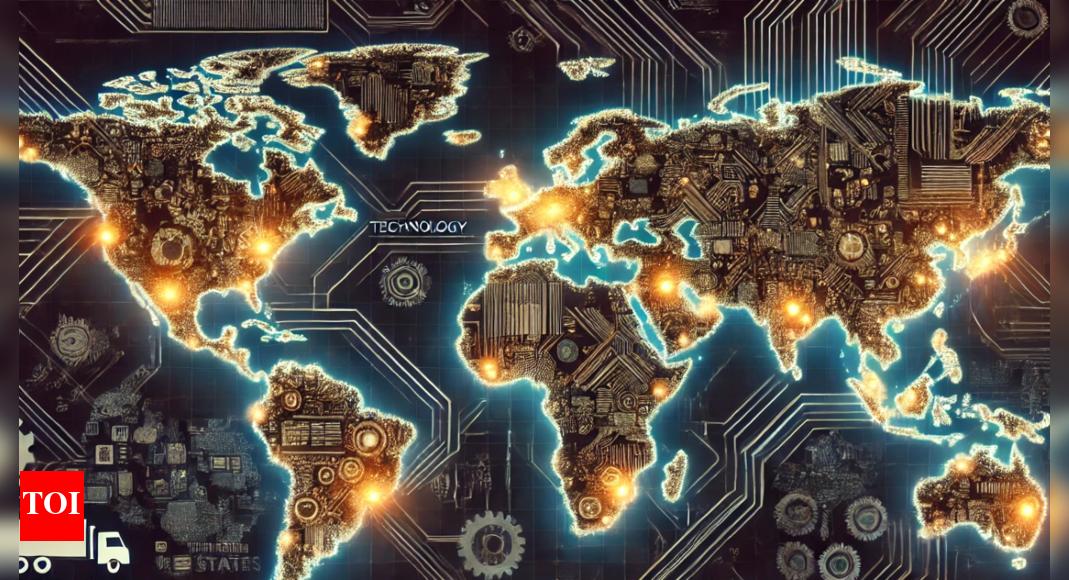World New Year New Year: Most of us people who are, watch, watch, eat and eat to catch us and judgments.
What we read, watch, browse, and eat, the headlines that grab our attention, the social media posts that confirm our fears and prejudices, the pills we take, and the weapons armies use—all this and more is controlled by a few networks of large companies. They have far more influence than any government.However, we hardly think about them.Biden talked about the technology and industrial complex.But that's just part of the story.Here's a tutorial
Introduction The Biden administration ends with the shadow of a superpower on America's political horizon — not foreign adversaries, but a network of entrenched industrial powers that overshadow traditional government power.These complexes—military, pharmaceutical, technology, fast food, news, and more—are not just powerful fields;They are transcontinental giants with a power that surpasses many nation states.As Trump prepares to assume the presidency, he doesn't get a blank slate;He derives this power from a global network of industries that operate across borders and beyond the reach of most governments.Their transnational hegemony dispels the illusion that states are the ultimate sovereign institutions.Rather, these complexes control supply chains, set trade terms, influence policy, and shape the world's economies and cultures.For all the patriotic rhetoric, many countries, including the United States, are now subject to these expanding powers—challenging the notion that the nation-state is the highest form of government.
Some of the industrial activities and their causes
- A sector dominated by large tech companies, social media platforms, and algorithm-driven businesses that profit by manipulating user behavior.By designing systems that encourage addiction, exploit personal data and rely on dark patterns, this industrial polis supports itself by fostering addiction and maximizing screen time.
- The combined market value of major tech companies (like Apple, Microsoft and Alphabet) often exceeds $10 trillion, but their annual revenue - and thus their direct contribution to the global economy - is closer to $5-6 trillion.
- Tested conditions: While it is possible to fill in the connections that cannot be explained, new and easy to grow from the use of the use of data.Algorithms that promote polarizing content or bad behavior can increase fraud but it comes at a social cost.
- Best countries
- America: - Home to technology giants such as Apple, Microsoft, Google and Amazon with innovations in software, cloud computing and artificial intelligence.
- China: With companies such as Huawei, Alibaba, Tencent and ByteDance, China dominates e-commerce, social networks and telecommunications infrastructure.
- South Korea: It is well known for famous giants like Samsung and SK Hynix and leaders in electronics.
global military-industrial complex
- Market value: $2.5 trillion annually
- A network of defense contractors, arms manufacturers and military service providers who benefit from continuing conflicts, tensions and arms races around the world.The more countries prepare for or engage in war, the more revenue they generate, creating an incentive to continue armed conflict rather than resolve it.
- Moral complexity: Although it is justified to spend a great deal on defense and protection, the profits of this industry are compounded by prolonged conflict, arming of nations, and even destruction.The more murder, death and destruction there is, the more products the complex can produce.However, some funds also go to peaceful and humanitarian missions.
- Gender dynamics and workforce composition: A significant part of the world's military-industrial workforce is made up of young men, often recruited as teenagers, which explains the increased vulnerability.Testosterone's influence on decision-making may partially explain the disproportionate number of men in combat roles and related occupations.This demographic skew is consistent with the observations of Scott Galloway (Prof. NYU Stern School of Business), who noted that governments have historically sent young people abroad to die for their nation.When examining the total workforce employed in all sectors of the military-industrial complex, women generally make up a smaller percentage than men.While the exact proportion varies by country and role, it is estimated that women make up about 10–15% of most direct combat or frontline roles, including higher representation in administrative, medical, and support positions.This imbalance raises the question of whether physiological factors such as testosterone's role in promoting risk-taking behavior contribute to the gender distribution of military jobs.
- Main countries:
- United States: The world's largest defense spender and leader in advanced weapons systems.
- China: Rapidly expanding its military capabilities, including naval assets, cyber defense and missile technology.
- Russia: A major supplier of military equipment known for advanced missile systems and air defense technology.
Global arts and entertainment industry conglomerate
- Market size: $2 trillion annually
- A conglomerate of media corporations, streaming services, record labels and art distributors that profit by encouraging the constant consumption of entertainment content.Rather than enriching culture for its own sake, the industry often prioritizes mass appeal and commercial success, sometimes at the expense of deeper cultural or intellectual value.
- This includes film, music, live performances, art and visual media.In recent years, combined entertainment has exceeded $ 2 trillion, including streaming services, blockbusters and international distribution.
- Picked up:
-Wens of Republic: Hollywood and the stream like Netflix and Disney + Error.
- India: The greatest national and international acquisition of competence in this position in the global film industry.
- South Korea: Center for global popular K-pop, Korean dramas and Hallyu cultural exports
The greatest point in human life |Scott Galloway X Rich Pack Podcast
Animal agriculture production complex
- Market size: $2 trillion annually
- An extensive network of livestock farms, meat processing plants, feed manufacturers and distribution systems that together power one of the largest and most influential industries in the world.By maintaining demand for meat and animal products, this complex thrives on industrial farming practices, unsustainable resource use, and reliance on antibiotics and animal monocultures.Its growth has exacerbated critical environmental issues such as deforestation, greenhouse gas emissions, and biodiversity loss.
- The meat and dairy industry that is constantly warming, approximately 26% of the world's work comes from livestock.In addition, more than 70% of the world's chicken biomass and almost 95% of the world's biodiversity.Ethical, with the slaughter of 100 million animals per year, and public risk, add to its challenges.
- Main countries:
- United States: One of the largest producers of beef, poultry, poultry and dairy farms and dairy producers.
- China: World's largest pork consumer and producer with growing demand for beef and poultry.
Brazil: - Beef and Poultry Export Business, Heavy Cattle Determining Infrastructure and Export Market were discussed.
Global Pharmaceutical Industrial Complex
- Market size: $1.5 billion annually
- pharmaceutical systems, biotech companies, and health care providers that support financial benefits when people are sick or dependent on continuous medication.Although treatment and stigma are beneficial, the profit motive can emphasize life-long presidription and expensive drugs as a solution.This model can be seen as a crisis economy in which the long-term health challenges always generate the demand that sustains the industry.
- Ethical: Medicines created have life-saving drugs, vaccines and benefits that have changed the health of the world.However, the same business caused the opioid problem in the United States through pre-marketing and selling to the patient.This high performance is important for building tension and good practice risk.
- top country:
- United States: Innovation and global sales for major companies, such as Pfizer, Specialty and Johnson & Johnson.
- Switzerland
- Germany: headquarters of large companies such as Bayer and Boehringer Ingelheim, known for their pharmaceutical research and production.
The problem with fast food
- Market size: $850 billion per year
- The Internet of fast food chains, processed food manufacturers, live outlets, and producers of packaged foods such as chips, bagels, and soda, which are part of the capital of convenience and crazy eating habits.By creating highly addictive, high-calorie, and nutritionally poor products, the systemic sector thrives on convenience-based consumer choice, often at the expense of public health.
- Moral Complexity: While providing affordable and convenient meals and encouraging economic activity, this complex's addiction to processed and nutrient-poor foods contributes to global health problems such as obesity, diabetes and heart disease.Aggressive marketing of unhealthy products, particularly to children and underserved communities, amplifies these public health challenges.
- Top countries:
- America: Birthplace of global fast food places like McDonald's, Starbucks, and Subway, and home to major packaged snack brands.
- China: Fast growing consumer market for both international fast food chains and domestically produced packaged snacks.
- Japan: Known for fast food and innovative offerings that adapt to regional tastes.
global news industrial complex
- Market size: $300 billion annually
- A group of news networks, media companies, and digital publishers that generate revenue through advertising, subscriptions, and content per click.Instead of sensationalist, polarizing reports and "angry media" and "angry media", this structure feeds balanced information on a stream of controversy and controversy.It functions as a systemic product that benefits from the endless interruption of headlines and divisive narratives.
- Moral complexity: the news industry plays an important role in measuring public awareness and sensitivity.However, the pursuit of clicks and advertising dollars can also damage sensational and misinformation, public trust, and discourse.
- top of the country:
- United States: Home of major networks such as CNN, The New York Times and Bloomberg that shape the global narrative.
- UK: BBC and Reuters are recognized worldwide for international news coverage and investigative journalism.
- China: Competitive state outlets such as CGTN and Xinhua are expanding the country's media with foreign influence.
Global Industrial Standards
- Market size: Estimated at 20 billion dollars per year
- A network of social media personalities, marketing agencies, and brand partnerships that benefit from superficial interactions and short-term revolutions.By promoting curative lifestyles and fostering a culture of fast consumption, it often rewards surface-level appeal with meaningful communication or real value.
- Ifry's impact industries, while small at around 20 billion a year, show signs of an emerging sector and the potential for natural growth.With increasing consumer trust in social media, high blocking rates, and many businesses changing budgets to influence marketing partnerships, these lines can see steep growth for the hockey puck.a stickOver time, as the digital platform works and manages the trade to gain respect, the market is ready to be freed quickly.
- Best country:
- United States: Platforms like Instagram and YouTube are home to some of the most recognizable influencers in the world.
- China: massive social platforms like royyin and piwi have created a clear storage economy.
- Brazil: With high social media engagement and a strong community of creatives, Brazil is Latin America's leader in influencer marketing.
Watch the Netflix episode of Maestro in Blue Explaining the Complexes of Influential Neologisms to understand the complexes You may have spotted some of them in the explainer - their definitions are below.
- Industripolis: a vast structure of industries that collectively form economies and societies, sustaining ongoing problems.
- Consultations: Hierarchies positions of powerful objects that matter since the wheels with the question of demand.
- Extract Complex: A program that extracts a number of problems without fundamentally solving them.
- Chrysonomics: an economic model in which revenues increase due to crises or systemic challenges, which are invested in security.
- Permanent industries: Industries that grow by maintaining ongoing requirements rather than providing definitive solutions.
- Systemic harvesting: organizations that profit from the continuous accumulation of systemic problems.








